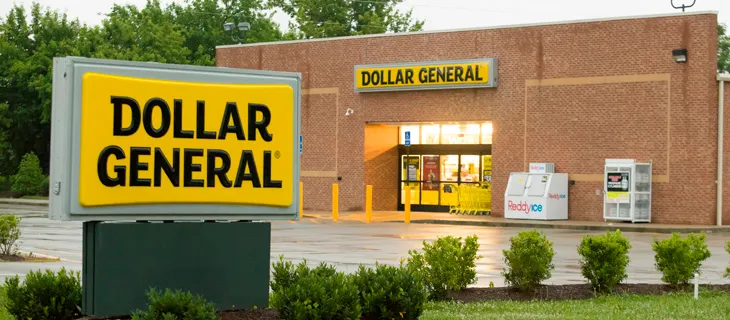GOODLETTSVILLE, Tenn. — Dollar General Corp. seems to defy the kind of gravity that is keeping much of the retail industry earthbound.
At a time when some retailers are scaling back their brick-and-mortar expansion plans and may see their profits constrained by the need to invest in their omnichannel offerings, Dollar General has been growing at a rapid pace and shows no sign of slowing down.
In recognition of the company’s ongoing success in growing its store base, its sales and its profits, the editors of Mass Market Retailers have named Dollar General the publication’s Retailer of the Year for 2019.
Though its fiscal year is not over, 2019 was certainly a year of celebrations for the Tennessee-based company. Not only did the company celebrate its 80th anniversary, it also cut the grand-opening ribbon on its 16,000th store in a community devastated by Hurricane Michael in 2018, all while remaining strongly dedicated to its mission of Serving Others and posting consistently strong financial results. To consider just one performance metric, Dollar General posted its 29th consecutive year of comparable-store sales growth for FY 2018 in March and recently announced third quarter 2019 results that beat Wall Street expectations.
“We are pleased with another quarter of strong performance across the business,” said Todd Vasos, Dollar General’s chief executive officer, during the call. “The quarter was highlighted by our best customer traffic and same-store sales increases in nearly five years, as well as double-digit growth in both operating profit and diluted EPS [earnings per share]. We continue to execute well on many fronts, while maintaining our focus on delivering value and convenience for our customers.”
Vasos added that Dollar General has a unique core customer, one who remains underserved by other retailers. By listening closely to the customer and understanding her needs, Dollar General has been able to tailor its assortment to provide her with an affordable fill-in alternative to larger-box retailers and grocers, which may be located several miles away.
“The consumer tells us how she’s feeling and where she believes she is going to be a year to 18 months from now,” Vasos says. “That’s why you see more coolers in our stores, and less apparel. She has told us that she doesn’t look to us for apparel like she used to, and she prefers that we help her fill in on the food side.”
These insights help guide the chain’s deployment of additional cooler doors throughout the store network. Vasos recalls that when he arrived at Dollar General in 2008, stores had five coolers on average.
Today, new stores in the traditional Dollar General format open with a minimum of 21 cooler doors, on average, while the slightly larger Dollar General Traditional Plus (DGTP) can feature 34 doors. A Dollar General Market, measuring about 17,000 square feet and offering meat and produce, contains 54 cooler doors.
The cooler expansion has enabled Dollar General to increase significantly its refrigerated and frozen offerings, which includes an assortment of dairy items such as milk, eggs and cheese, frozen fruits and vegetables, and lean proteins.
By the end of fiscal 2019, the company expects to carry produce in approximately 650 stores. The company’s transformational refrigerated and self-distribution initiative, referred to as DG Fresh, is expected to enable the company to reduce costs and improve margins by negotiating with and purchasing directly from suppliers while reducing its reliance on third-party distributors.
In addition, DG Fresh is expected to improve the stores’ in-stock levels. As of the end of the third quarter of 2019, the company had approximately 4,900 stores being supplied from four (soon to be five) fresh distribution centers, all of which were opened in the course of the year.
The speed of the transition is staggering. At an average of approximately 250,000 square feet, the fresh facilities are much smaller than Dollar General’s traditional dry distribution centers, which measure around 1 million square feet or more. In order to capture economies of scale on transportation, Vasos says, the facilities often may be located close to the larger dry warehouses.
Another transformational initiative is Fast Track, a multipronged program intended to enhance store level stocking productivity and simplicity, allowing store teams to concentrate on customer service. The Fast Track initiative also involved changing the layouts in the chain’s dry distribution centers to allow for more efficient sorting and packing.
An important element of Fast Track is working with Dollar General’s suppliers to provide shelf-ready case packaging.
“When we get shelf-ready package sizes, it ensures that when the product comes off the truck, it all goes to the shelf, which means we will be in-stock for the shopper, and it will take less time for our employees to restock the shelf,” Vasos explains. “We believe that in partnership with our CPG partners, we can increase the amount of shelf-ready packaging, which should support both sales and customer satisfaction.”
Fast Track also includes a self-checkout component, which the company believes can further improve the speed of checkout and leverage the company’s convenience proposition. Self-checkout is currently being tested in a small number of stores, but Vasos says that the early results are encouraging.
All of the work under way at Dollar General continues to reflect its business model, based on great value and convenience. That model continues to demonstrate it works in all macroeconomic climates: when times are bad and when times are good. By offering assortments that combine trusted consumer brands with affordable private brand options presented in clean, convenient and well-organized stores, the retailer has succeeded not only in winning the loyalty of its core shopper but attracting new consumers drawn by great values on known brands.
At Dollar General, the customer is at the center of every decision, and it’s been that way since the company’s inception as a wholesale venture born out of the Great Depression more than 80 years ago between J.L. Turner and his son, Cal Turner Sr. The father-and-son duo’s success in wholesaling eventually gave way to retail and the first Dollar General store opened in 1955.
Much has changed since then, but Dollar General’s focus on fulfilling its mission of Serving Others hasn’t wavered. That culture and the company’s core values are a treasured legacy of the Turner Family and are reflected in the work of the Dollar General Literacy Foundation to eradicate illiteracy in the communities Dollar General calls home.
In 1993, Cal Turner Jr. founded the Foundation to recognize and honor his grandfather (J.L. Turner) who was functionally illiterate and whose father died unexpectedly when he was in the third grade, necessitating that he drop out of school to financially support his family.
Since its establishment, the Dollar General Literacy Foundation has awarded more than $172 million in grants to nonprofit organizations that have helped more than 11 million individuals learn to read, prepare for high school equivalency tests or learn English as a second language.
Vasos is a staunch steward of the company’s mission.
“The Turners left us with a strong culture of Serving Others, and it really is part of the very fiber of this company,” he says. “Simply put, we are a mission-driven company where decisions are guided by wanting to best serve our customers. From how we operate stores, the strategic initiatives under way and the products available on our shelves to the ability we provide to help Americans save money and improve the communities we proudly call home, I would tell you that, when it comes to this mission and our ability to serve others across the country, this company walks the walk.”







